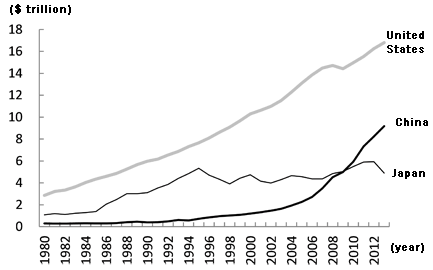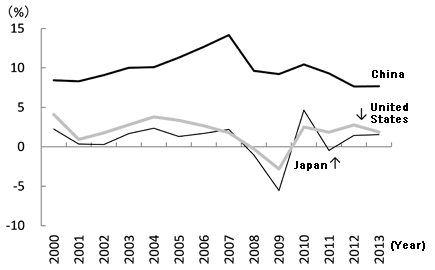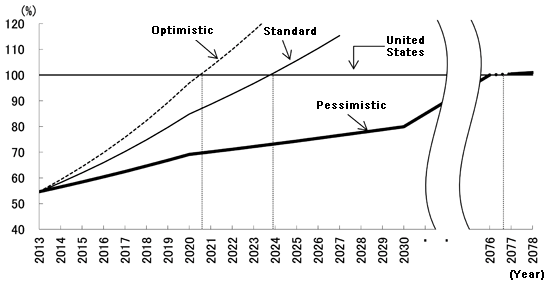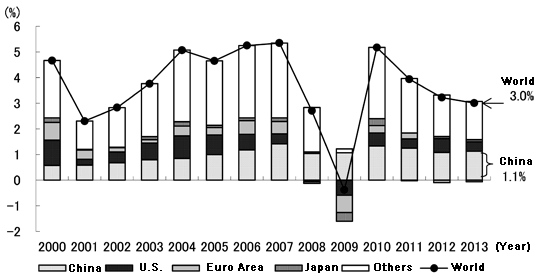In China as Number 1 (Toyo Keizai Inc.) published in 2009, I compared the strength of the Chinese economy with that of other economic powers such as the United States and Japan in terms of major indicators including gross domestic product (GDP), trade volume, foreign exchange reserves, and automobile and steel production, and predicted that China's GDP would overtake that of the United States to become the largest in the world by 2026. There were many objections to this view from the beginning, and, more recently, with the economic growth in China slowing significantly, the argument that “China as Number 1” will end up being an illusion has become even more prominent. However, given that China is still growing much faster than the major countries, the presence of China has continued to increase, and the era of “China as Number 1” is drawing closer and closer. Based on the criterion of whether China's GDP will eventually top that of the United States, the probability of “China as Number 1” ending up as an illusion is very low.
Pessimism unfounded
Toshiya Tsugami, a consultant specializing in modern China and a former official of the Ministry of Economy, Trade and Industry (Director of the Northeast Asia Division, the Trade Policy Bureau), is the most active person in developing a pessimistic view on the future of the Chinese economy. In his book, Chugoku Taito no Shuen (End of China's Rise) (Nikkei Publishing Inc., 2013), Mr. Tsugami concluded that the day when China's GDP will overtake the United States and become the largest in the world will never come, as its growth rate from now on will be around 5% at best. As the basis for this argument, he cites the following short-, medium-, and long-term problems facing China.
First, as the short-term problem, public spending in response to the collapse of Lehman Brothers, including the economic stimulus measures that amounted to four trillion yuan, has created excessive production capacity, potentially leading to an increase in bad debt.
For the medium-term problem, upward pressure on wages is rising in China in the wake of the arrival of the “Lewisian turning point,” which signals the drying up of excess labor in rural areas. To solve this problem, China needs to enhance productivity through deregulation and privatization. In reality, however, the state-owned sector is expanding at the expense of private-sector companies, while the dual structure of urban and rural areas has prevented farmers from moving to cities and pushed labor costs even higher.
Finally, regarding the long-term problem, China has to face the problems associated with population aging and declining birth rate before it reaches the stage of developed countries.
It is true that these factors are restraining growth in the Chinese economy, but it is still too early to conclude that the rise of China will come to an end any time soon and that “China as Number 1” will end up being an illusion. With a per capita GDP of only $6,747 in 2013, much lower than those of developed nations, such as the United States ($53,101) and Japan ($38,491) (both numbers are based on data from the International Monetary Fund, World Economic Outlook Database, April 2014, which include estimates), China still enjoys significant advantage of being a latecomer, which provides abundant room for industrial advances and technology transfers from overseas (note).
Timing at which China's GDP will surpass that of the United States
China's GDP stood at $4.52 trillion, a size equal to a mere 30.7% of that of the United States and 93.2% of that of Japan in 2008. However, China surpassed Japan to become the second largest economy in the world after the United States in 2010 in terms of GDP, which reached $9.18 trillion, equivalent to 1.87 times that of Japan and 54.6% that of the United States in 2013 (Figure 1). This reflects the fact that the economic growth rate in China is still much higher than that of major countries such as the United States and Japan, although it has been declining in recent years (Figure 2). The appreciation of the yuan against the dollar and the yen has also contributed to the surge in China's GDP relative to the United States and Japan.
— Comparison with the United States and Japan —


If we estimate the timing when the GDP figures for the United States and China will trade places based on those in 2013 using three scenarios—optimistic, standard, pessimistic—taking into account the growth rates of China and the United States and changes in the exchange rate of the yuan against the dollar (more precisely, the real exchange rate that takes into consideration changes in the relative price level between the two countries), we project that China's GDP will surpass that of the United States in 2021 in the optimistic scenario, 2024 in the standard scenario, and 2077 in the pessimistic scenario (Figure 3).
—Projection of the China/U.S. GDP ratio—

| Period | Optimistic | Standard | Pessimistic | ||
|---|---|---|---|---|---|
| GDP growth | China | 2014-2020 | 8% | 7% | 6% |
| 2021-2030 | 6% | 5% | 4% | ||
| 2031 - | 5% | 4% | 3% | ||
| U.S. | 2014 - | 2.5% | |||
| RMB's appreciation against the U.S. dollar in real terms | 2014 - | 3% | 2% | 0% | |
| Source: Compiled by the author based on official statistics of the United States and China in 2013. | |||||
Unshaken position of China as a global economic power
Even before China's GDP surpasses that of the United States, China's contribution to the growth rate of the world economy has already exceeded that of the United States, reaching 1.1% in 2013, which is equivalent to 36.7% of global growth (3.0%) (Figure 4). The contribution of a country to the growth rate of the world economy is calculated by multiplying the growth rate of the country by its share of total world GDP (based on purchasing power parity). Although China's growth rate has declined recently, its contribution to the global growth rate has remained high, thanks to its rising share of world GDP.
Looking at the issue from an industrial level, Chinese crude steel production reached 779 million tonnes in 2013, maintaining the leading position since 1996 and leaving Japan, which has the second largest steel production (111 million tonnes), far behind (Table 1). In addition, auto production in China stood at 22.12 million units in 2013, twice that of the United States (11.05 million units) (Table 2).

Contribution of China in 2013: (1.1%) = (7.7%) × (14.7%)
Contribution of the U.S. in 2013: (0.4%) = (1.9 %) × (19.5%)
| (Million Tonnes) | ||
| 2008 | 2013 | |
|---|---|---|
| China | 550 | 779 |
| United States | 91 | 87 |
| Japan | 119 | 111 |
| Source: Compiled by the author based on World Steel Association | ||
| (Million units) | ||
| 2008 | 2013 | |
|---|---|---|
| China | 9.35 | 22.12 |
| United States | 8.68 | 11.05 |
| Japan | 11.56 | 9.63 |
| Source: Compiled by the author based on data from the China Association of Automobile Manufacturers for China and the automobile statistics monthly of the japan automobile manufacturers association for japan and the united states. | ||
In terms of trade, China is now the world's largest exporter and second largest importer after the United States. Totaling exports and imports, China became the world's largest trading power in 2013, overtaking the United States for the first time (Table 3).
| ($ billion) | ||||||
| Exports | Imports | Total exports and imports | ||||
|---|---|---|---|---|---|---|
| Rank | Country | Amount | Country | Amount | Country | Amount |
| 1 | China | 2,210 | United States | 2,331 | China | 4,160 |
| 2 | United States | 1,579 | China | 1,950 | United States | 3,910 |
| 3 | Germany | 1,453 | Germany | 1,187 | Germany | 2,640 |
| 4 | Japan | 715 | Japan | 833 | Japan | 1,548 |
| 5 | Netherlands | 664 | France | 681 | France | 1,261 |
| 6 | France | 580 | United Kingdom | 654 | Netherlands | 1,254 |
| Note: In 1978, total exports and imports of China were $20.64 billion, ranked 27th in the world. Source: Compiled by the author based on WTO data | ||||||
In the financial arena, China's net external assets have been increasing rapidly, reaching $1.97 trillion at the end of 2013 (the State Administration of Foreign Exchange, “The Report of China's International Balance of Payments 2013”), the second largest after Japan with $3.11 trillion (a preliminary estimate by Japan's Ministry of Finance). In particular, China's foreign exchange reserves were $3.88 trillion, about three times that of Japan ($1.27 trillion). Adding in the expected progress in the liberalization of capital transactions in China, overseas investment by private-sector companies, in addition to the existing investment of foreign exchange reserves by the government, is expected to become more and more active. In the future, the influence of China on the world economy is likely to continue to increase not only in the real economy but also in the realm of finance.


